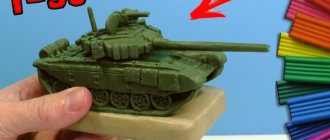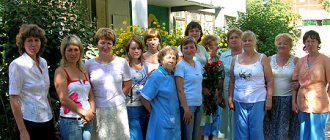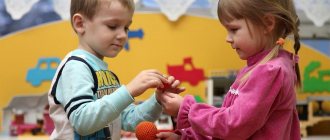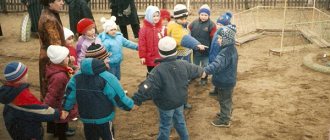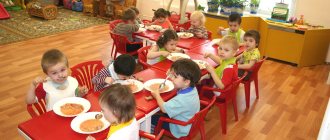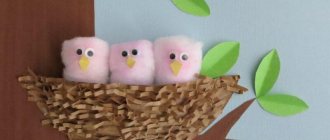Touching children's drawings and crafts made from plasticine, cardboard and improvised materials are so cute and labor-intensive that you don’t even dare throw them away or put them in the closet. Creativity requires contemplation and honors for the work done. To stimulate a child, you need to put his works on display. This can be done creatively - so that the room acquires additional designer decor.
1Frame in frames
Place the best, favorite and unusual children's drawings and applications in frames and find the best place for them in the room. Place other drawings nearby and periodically replace them with new ones.
Instagram @_isastateofmind
Instagram @room_boom_boom
Instagram @summit_drive_design
For a kindergarten, such exhibitions have their own significance - it becomes possible not only to attract parents to participate in the events of the kindergarten, but also to give many parents the opportunity to become participants themselves. Carrying out such events helps to instill moral values in the child, introduces them to national culture, Russian folk art, and instills respect for talented Russian masters.
In our kindergarten, for several years, based on the work plan of the “Folk Alphabet” circle, several exhibitions of folk and applied art were held. This is an exhibition of samovars “We don’t miss tea”, an exhibition of Gzhel ceramics “The Winter Tale of Gzhel”, an exhibition of boxes “You, box, open!”, an exhibition of bells “Under the arc the bell is ringing”, an exhibition of wicker baskets “There is a little bit of everything in the autumn basket” , linen products “You grow, my little flax.”
Each exhibition includes: an excursion - an activity for children, an excursion-consultation for teachers, as well as a visit to the exhibition by parents.
The form of the exhibition for children may be different. This is an integrated activity, an activity - a conversation, a conversation with tea drinking, a game activity, entertainment.
Excursions for teachers are conducted within the framework of the pedagogical atelier “Folklore School for Everyone,” the purpose of such excursions is consultation with the subsequent implementation of knowledge in work and independent excursions for children in their group.
Parents enjoy visiting such exhibitions, because for them children often act as tour guides or organize a small thematic concert.
The kindergarten staff provide great assistance in collecting exhibits, since our small northern city is relatively young, and it is not easy to find museum rarities and family heirlooms in it. But fortunately, the team has many caring and enthusiastic people who bring rare household items and exhibits for exhibitions from home and collect them from friends.
In the kindergarten, a “Merry Room” has been decorated, a room for conducting classes of the “Folk Alphabet” circle, in the design of which parents also provide invaluable assistance. Antique embroidered tablecloths, towels, homespun rugs and runners, clay pots, wooden barrels and bowls, several pairs of bast shoes woven from bast - this is not a complete list of household items in the “upper room”. And many of these items were donated by the students’ parents. During the circle classes, children have the opportunity to touch products that retain the warmth of the hands that created these antiques and have come down to us.
A large photo album introduces exhibits from past exhibitions, because their themes are not repeated, and the circle participants are updated. This way, children and parents have the opportunity to see past exhibitions in photographs.
Every autumn, replacing kindergarten graduates, new preschool children will cross the threshold of the “Merry Room”. There will be new exhibitions, new excursions, new encounters with antiquity for them. And their parents will already take out, by the way, not sent into oblivion, antique vases or boxes, embroidery or scarves - who knows what will become the topic of the next
Exhibitions. After all, the main thing is that we keep it, which means we respect and remember those from whom we inherited these objects dear to our hearts, and we will try so that our children also do not forget their ancestors, their roots, and therefore us.
“WE DON’T MISS HAVING TEA”
Exhibition of samovars for children and parents with tea drinking.
Goal: to create a sense of respect and pride for the talented craftsman of the Russian people, introducing them to Russian national musical culture and art.
Children and their parents go to the music room, where there is an exhibition of samovars. Russian folk music is played by an orchestra of folk instruments.
Presenter: Steam above, steam below - our Russian samovar hisses.
Famous Russian poets and writers have already said a lot about traditional Russian tea drinking. And not without reason: after all, Russian people are considered almost the biggest tea lovers in the world. Our talented ancestors showed themselves in this area: not being satisfied with the ordinary kettle used in other countries, they invented the samovar in the Russian city of Tula more than 300 years ago. The water in it boiled quickly and did not cool down for a long time, and both wood chips and pine cones were suitable for kindling.
Samovars became widespread in Rus'. They were given very different shapes, the imagination of the craftsmen knew no bounds: samovars - balls, glasses, vases, pears, barrels and much more. If you look at the exhibits in our exhibition, you will notice many of the things listed here. Silver was used to decorate samovars, the handles were decorated with carved bone, and the faucets were made in the shape of a key. They produced samovars for all occasions: from five bucket samovars, tavern samovars to small ones with 1-1.5 glasses, aptly nicknamed by the people “the selfish samovar” or “a bachelor’s delight.” Travelers took a special cellar on the road: it contained a basket for tea drinking, consisting of two cups, a saucer, a sugar bowl, two spoons, matches and a samovar on an alcohol lamp. (visitors look at samovars)
Presenter: Samovars were decorated with various inscriptions, for example: “The samovar is boiling, don’t tell you to leave” or “Where there is a samovar, there is paradise under the fir tree.” Some samovars bear the inscription and coat of arms of the city of Tula. The wealth of the family was judged by the beauty and decoration of the samovar - the more richly decorated the samovar, the more prosperous the family.
Having become an indispensable accessory of Russian life, the samovar took a central place in many paintings by Russian artists. Here we will look at illustrations of the paintings “The Merchant's Wife Drinking Tea”, “The Blue House” by B. Kustodiev, “Alekseich” by K. Makovsky. (examining reproductions of paintings)
Presenter: The Russian people came up with riddles about the samovar that our guys know and will now tell each other and all of us:
1. The fat man stands with his barrel akimbo, hissing and boiling, telling everyone to drink tea (samovar)
2. Four legs, two ears, one nose and belly (samovar)
3. Vanya stands, there’s a bathhouse in his belly, it’s boiling, hissing, and orders him to drink tea (samovar)
4. There is a hole at the top, a hole at the bottom, and in the middle there is fire and water (samovar)
Presenter: In Rus', tea acquired the status of a national drink. Special utensils for tea appeared, and the tea table was bursting with all kinds of sweet pies, cheesecakes, cookies, jam, and cakes.
Tara - bars, rastabars, let's drink tea from the samovar, With crackers, with crackers, with sweet cheesecakes.
Despite the advent of modern utensils, the samovar survived; it became electric. They also make decorative porcelain samovars for gifts. Metal samovars are sometimes painted. Here you see several examples of painted samovars. This is mainly a floral pattern - flowers, berries, curls. The samovars come with small teapots and trays (viewing the exhibits)
Presenter: Along with foreign teapots used for tea drinking, almost every family has preserved a samovar. We can see this from the numerous exhibits you brought from home for the exhibition. After all, drinking tea from a samovar is not just food, but a special ritual that unites the family and gathers it around the table. In the summer, especially at the dacha or in the yard, the whole family gathers around the samovar and begins a leisurely tea party with leisurely conversations.
We don’t miss drinking tea, we carry on a conversation over tea, bring the samovar to the table, talk about this and that...
N. Berdnikova.
Our ancestors did not drink tea from mugs, but poured it into a saucer, which they held by the bottom. There are many sayings about tea that you guys have prepared especially for our meeting today with your parents. (Children take turns speaking)
1. “Drink some tea and you’ll forget the melancholy,”
2. “No one choked on tea in Rus',”
3. “There’s no harm in tea,”
4. “Drinking tea is not cutting wood.”
Presenter: On the tea table, among the buns and jam, gingerbread takes pride of place, the homeland of which is the same glorious city of Tula. It is not for nothing that they have long been written on them: “I come from Tula - the brother of the samovar,” “If you want to take a sip of tea, don’t forget about me.” Gingerbread got its name for the spicy taste and aroma that various spicy additives give them: cinnamon, cloves, nutmeg. Gingerbread cookies were decorated with paintings; sometimes entire cities and houses were depicted on them. There are also printed gingerbread cookies - they are made using special molds. Sometimes gingerbread cookies are made in two layers, sandwiched with marmalade and jam. These are Tula or Vyazma gingerbreads. Gingerbread is one of the most common treats. They greeted guests and celebrated holidays. But there were also “accelerating” gingerbreads, upon receiving which, guests who had stayed too long were obliged to leave the hospitable home. Russian gingerbread at the World Exhibition in Paris in 1898 received the highest award.
And now you are welcome for a cup of tea,
This is how we live, we chew gingerbread, drink tea,
We invite everyone to visit!
Then everyone sits down at the table on which the samovar stands and treats themselves to tea and gingerbread.
“THE AUTUMN BULK HAS A LITTLE BIT OF EVERYTHING”
EXHIBITION OF BASKETS AND WICKER PRODUCTS FROM WINE.
Game activity for children - "Folk alphabet" group.
Program content: to cultivate a respectful attitude towards the work of the talented Russian people; introduce products of Russian folk crafts; continue to listen to musical works performed by the Russian folk orchestra; activate children in Russian folk games; master the techniques of playing spoons.
Musical director: Today, guys, we will go to the exhibition. This is an exhibition of wickerwork, i.e. woven from wicker twigs, grass, and thin strips of tree bark.
(entrance to the hall, inspection of products) The Russian folk melody “The Moon is Shining” is played on a recording, performed by an orchestra of folk instruments.
Presenter: The Russian land is generous and rich in talented craftsmen. Since ancient times, folk craftsmen have learned to use natural materials, i.e. from what grows around us, what mother nature gives us, create products or things that were necessary in everyday life, on the farm. From the simplest primitive ones to the beautiful ones, intricately decorated with complex weaves and multi-colored patterns (examination of exhibits)
— Among them are baskets or baskets of various shapes, in which you can keep a lot of necessary things. We will look at the baskets located on these benches (they are looking at them). When going to the forest, a person took a basket with him to collect the gifts of the forest. What does the forest give us? What can you put in a basket in the forest? (children's answers - berries, mushrooms, cones).
— In the garden or vegetable garden, a basket is also necessary. The harvest was collected in it: everything that grew on trees and bushes. What do you guys think, what can be put in a basket in the garden, and what in the vegetable garden? (children's answers: vegetables in the garden or fruits in the garden).
— And here, on these tables, there are utensils: bread bins, crackers, plates, dishes. You can store bread products, various dried goods, crackers in them, and you can store souvenirs.
— Skilled hands could create real trunks or suitcases from wooden twigs; even furniture woven from vine twigs decorates some houses or verandas (examination of samples).
Wicker plates on the walls look very beautiful and unusual; they decorate any interior and give them a special flavor.
“And from the bark of the linden tree, which was called bast, they learned to weave light shoes - bast shoes. They, of course, wore out quickly and did not last long, but it was not difficult to weave new bast shoes. But these slippers are woven from thick stems of grass. Where wood was rare and expensive, grass and straw could be used for weaving, and here you see products made from these materials. (child tries on bast shoes)
(go to a separate table, on it there are 3 baskets and a wicker suitcase.)
Musical director: Guys, look at these baskets. It's autumn outside. And in the fall there’s a little bit of everything in the basket. Now we will look into this basket (looks under the lid)
-Autumn put riddles for us in this basket, and now I’ll tell you them.
1. It’s big, like a soccer ball, if it’s ripe, everyone is happy! It tastes so good, what kind of ball is this? (watermelon)
2. Yellow, but inside it is white, will give a bunch of green arrows. As soon as you cut it, tears will immediately come out of your eyes. (onion
3. The rounder and redder one tastes the best in a salad. And the guys have been very fond of it for a long time... (Tomato)
4. It is completely green and oval, elongated, the Tomato’s faithful brother, also asking to be included in the salad. Have you finally figured it out? What is this? (cucumber).
(Take each guessed vegetable out of the basket and show it to the children) A musical game is played: “Whose circle will gather faster” (in the center of each circle there are baskets of different shapes)
Presenter: And in this basket, autumn has prepared a forest riddle for us: The harvest in the forest is ripe - everyone takes the baskets. Who can guess what we will collect? (mushrooms)
Child: We walk through the forest and choose mushrooms. We don’t take everything in a row - we won’t take fly agaric mushrooms.
Children sing the song: “Let’s collect mushrooms,” music. etc. E. Kosheleva.
Presenter: And there are a few berries in this basket. Here are autumn rowan berries. People came up with a saying about the autumn rowan: “In September there is only one berry, and even that is a bitter rowan.” Let's repeat this saying together (children repeat the saying)
The song “Everything from the Russian Rowan Trees” performed by N. Kadysheva, the audio cassette “Golden Ring” are played, the children perform a dance - a round dance.
Presenter: Now look at this table: Here is a wicker suitcase, it is covered a little, We will now open it - here under the lid of a spoon.
Child: Wooden friend, without her we are like without hands. At her leisure she is cheerful and will feed everyone around her.
Musical director: And we will continue to master the techniques of playing spoons.
“Kalinka” is a Russian folk melody, performed by children on spoons.
Presenter: Yes, autumn is generous with gifts, it’s not without reason that they say, “Autumn supplies, and winter picks up.” Everything that the generous autumn fills our baskets with will be useful on the table during the long cold winter and will delight us with its taste.
Our excursion to the exhibition has ended. We looked at the wonderful products woven by Russian craftsmen. The Russian land is generous with skilled and talented people. Honor and praise to them.
Musical director:
Yes, this is how it goes in Rus', That the talented people are themselves both a reaper and a Swiss, And a player on the pipe. And he will forge a flea, he will build a good house, he will handle all the utensils around the house, that house will become a cup full.
N.Berdnikova.
Presenter: Now let's look into the last basket: it's autumn here - the shepherd has prepared a treat for us: autumn fragrant apples (treats the children).
When parents visit the exhibition, children organize a small concert:
- Poems about autumn
- Performance of the song “Let's collect mushrooms, music. etc. E. Kosheleva
- Poems and riddle about rowan
- Dance - round dance “Everything from Russian mountain ash”
- “Whose circle will gather sooner”, Russian folk melody - musical game
- Poems about spoons
- “Kalinka”, Russian folk melody – ensemble of spoon players.
Winter paper crafts
Kids work with ready-made forms made of paper or cardboard, which the teacher cut out in advance. Using a safe glue stick, you can use them to make appliqués and simple three-dimensional shapes that even a junior beginner can handle.
Older children can mark the template and cut out the shapes themselves. In this case, the paper can be either purchased or waste - scraps of silk or textured wallpaper of the appropriate color can become both part of the composition and an excellent background.
Snowman
There are hundreds of options on how to add a snowman to your winter crafts with your own hands. For a volumetric option, you can use cotton wool, rolled into balls and colored toilet paper, cones, plastic bottles and even plastic cups.
A light and unusual snowman will be made from white threads and a balloon. The very idea of such a winter craft will appeal to children of any age.
To work you will need:
- threads (fluffy ones are easier to work with);
- small balloons;
- starch and accessories (hat, buttons, nose).
The balloons must be inflated to the desired size and tied tightly. We wind the threads around the balls, crossing them randomly. There is no need to achieve a solid ball; a spectacular web is enough. Soak the finished balls for 1-2 hours in a strong starch solution and then dry. After this, the balls can be carefully deflated or pierced, and the finished forms can be used to create a snowman.
The same variety of techniques can be offered for flat applications. Even if children do not know how to cut yet, they can take ready-made materials:
- paper napkins with lace edge;
- cotton pads;
- cotton wool glued in pieces;
- fabric scraps.
Even if children repeat the work after the teacher, at the end of the lesson you can offer to show imagination and add a New Year’s theme to the work - decorate the collage with sequins or confetti, turning them into Christmas tree decorations on painted New Year trees.
Other ideas:
